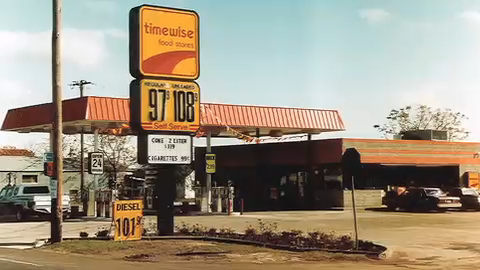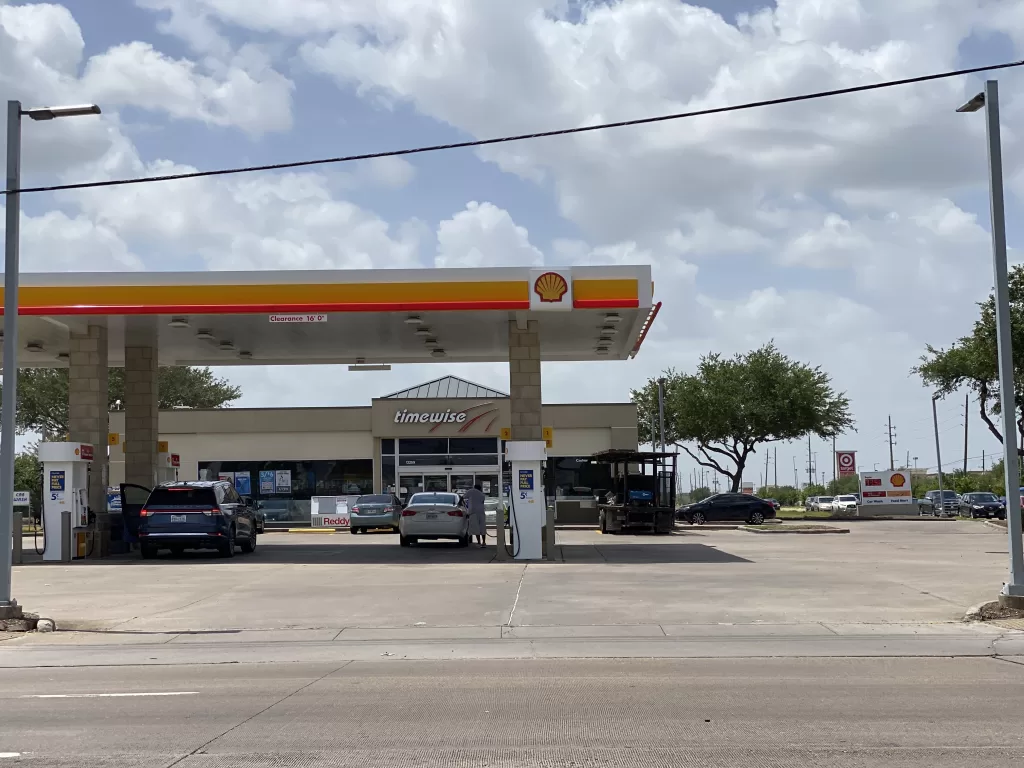Howdy folks, and welcome back to Houston Historic Retail. Today, we’re checking in with Houston’s most prominent homegrown C-Store chain, Timewise. Just over a year ago, Shell Oil Co. completed its purchase of Landmark Industries (the parent of Timewise). Since the acquisition, there have been plans to sell off 64 locations, which seem to be bound by contract to sell Exxon fuel. New England-based Global Partners announced their plans to pick up these stores a few months back. Of the many brands Global Partners operates, it’s unknown which one they will bring to Houston. However, we can expect to see these changes to our retail landscape soon. Before this significant split, though, let’s take a few minutes to do a deep dive into the history of Timewise/Landmark Industries.

Most histories of Timewise start with their founding in Hempstead. While this is true, it’s essential to consider the context of the formation of Timewise. Landmark Industries was a group effort consisting of former Tenneco Oil employees and a few of their friends. Hempstead was a low-competition market, and the brand-new store drove considerable traffic. After the first store’s success, Landmark began to purchase existing gas stations in older areas of Houston. By 1989, the group would be up to 15 stores and also expand into San Antonio. By the early 90s, the stores were becoming somewhat of a known quantity. Timewise gained a reputation for being clean, safe, and reliable in an era when competing independent gas stations couldn’t always offer the same. Over the next few years, Timewise would continue adding locations. Some were by purchase, but an increasing number were new constructions. For these new stores, Timewise simply chose to build their stores to whatever standard the aligning gas station brand utilized. They would include an orange Timewise sign, and the products and cleanliness would be up to their standards. Still, these gas stations wouldn’t look any different than a generic “Food Mart,” usually located under the canopy.

By the early 90s, Timewise saw a new opportunity. New suburban development in Houston was again booming, with substantial new master-planned communities popping up for the first time in years. However, a lack of representation by national C-Store chains, which mainly had exited or were preparing to exit Houston, put Landmark Industries at an advantage. However, Landmark would need to develop a new concept; while Timewise was a success in its own right, Landmark Industries was going after a completely different demographic. These new locations would be wildly different, designed to look somewhat like an old-fashioned general store and using the “Country Store” name. They would be built in a planned community, sporting the name of the development, e.g., The New Territory Country Store in Sugar Land. After building the first couple of locations, the Country Store concept would begin adding space to sublet. Mostly to dry cleaners and similar services, but shortly after experimenting with larger stores and seeing a promising market, Landmark began building Country Stores with attached fast-food restaurants. These new Country Stores were an immediate hit and would quickly expand across all sides of Houston. Throughout the 90s, Landmark Industries would continue to build a few Timewise locations; however, their new concept really became their bread and butter. By the end of the 90s, the Country Store manian even hit the city proper, with a C-Store attached to a strip center, a concept which had died off in the 80s!
By the 2000s, Landmark was almost exclusively building its Country Store locations, expanding as far west as Junction (over 100 miles West of San Antonio). This time period also brought some experimenting with the future of the brand. Houston was overrun with gas stations, and while Country Stores had done well, it was difficult for Landmark to make many successful moves in Houston. As such, the company started experimenting with travel centers. The first in Laredo would operate until only a few years ago under the name “Fuel Express” before switching to Timewise, but it started to resemble the modern store design. They would even mesh the Country Store concept with a Travel Center in nearby Rosenberg, although this location was sold in 2010. In 2004, opportunity would present itself as Landmark picked up nine corporately owned Chevron stations, as the company decided to exit the Houston market. Some of these locations contained McDonald’s, which helped build the connection between the restaurant and the gas station. The purchase of these corporate stations would open a floodgate of expansion.

Later in 2004, Landmark would pick up nearly 20 corporately operated Shell locations throughout San Antonio. Since the company had already established the Timewise brand there years ago, it was an easy win. Months later, Lanndmark would purchase even more locations after Shell announced plans to divest themselves of their C-Stores by 2010. Landmark was at nearly 100 locations, split between the Timewise and Country store banners. The company had become so big it was leasing out stores that had been unprofitable for them and had started to supply fuel around this time. All throughout, the company also continued to build new locations. When Shell created the timeline to exit retail, it pulled a 2006 exit of Houston. Many of the locations here date back to the 60s and provide extensive coverage of the highway system. When the time for the spin-off came, Shell ensured success by forming a 50-50 joint venture with Landmark Industries. The new company, Texas Petroleum Group, would run C-Stores and provide fuel to locations they leased out to independent operators. The deal included 162 sites; 72 locations would be converted to Timewise stores, and the others were leased out as they did not meet Timewise’s expectations. Admittedly though, during this time period, each location varied wildly. As mentioned, the sites were quite old. Some were (and continue to be) non-enterable attendant box-only stations. Some were more modern Food Mart-style locations.

The Shell acquisition was a great success, and two years later, when Exxon announced they wanted to take On the Run out of the Houston Market, Timewise again stepped up, purchasing 80 locations this time. With a mishmash of formerly corporate O&O stations, Timewise built the base we know today. Over the next few years, Landmark would begin to replace some of their oldest locations, Shell and Chevron, building some of their final Country Stores. They sought a new design to update Shell locations within the city. This would be a new iconic look for Timewise created by Interplan, which works with Buc-cee’s, Star Stop, and many other Houston gas stations. The new design of Timewise and the name recognition proved so popular that Timewise would eventually drop the Country Store name. Electing to build new combo McDonald’s Timewise locations on the edges of master-planned communities instead. It also made sense to drop the Country Store name in most spots, as development in Houston has been largely unstopped since the 90s. As Timewise became the dominant brand, it became one of the most prevalent names in Houston South Texas C-Store chains. In a market where competition was Stripes, Circle K, 7-Eleven, CornerStore, and many other small brands all vying for market share, Timewise’s consistency helped them stand out. This attention was, in fact, so positive that Shell, who decided to re-enter the United States retail market in 2018 with their Shell Select brand (which had a location in Houston during its test run about 20 years ago), purchased Landmark Industries just over a year ago. As a part of the purchase, Shell agreed to sell off the former Exxon Corporate sites to a third party, Global Partners, which mainly operates out of New England under a few different brands. At this point, it appears that Global Partners is operating under the Timewise brand through some sort of agreement. While we can’t predict precisely what will change, this is an opportunity for positive change in the Houston C-Store sector.


